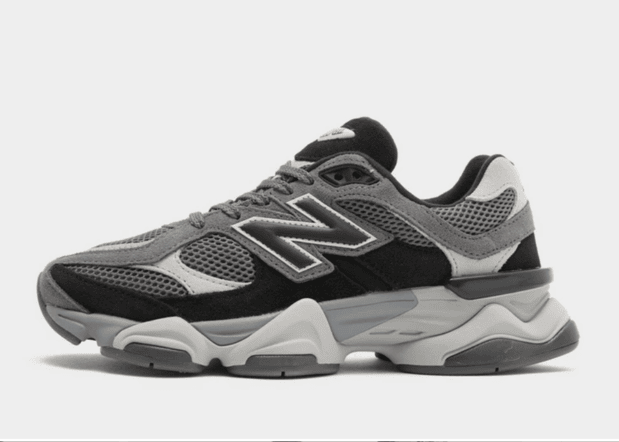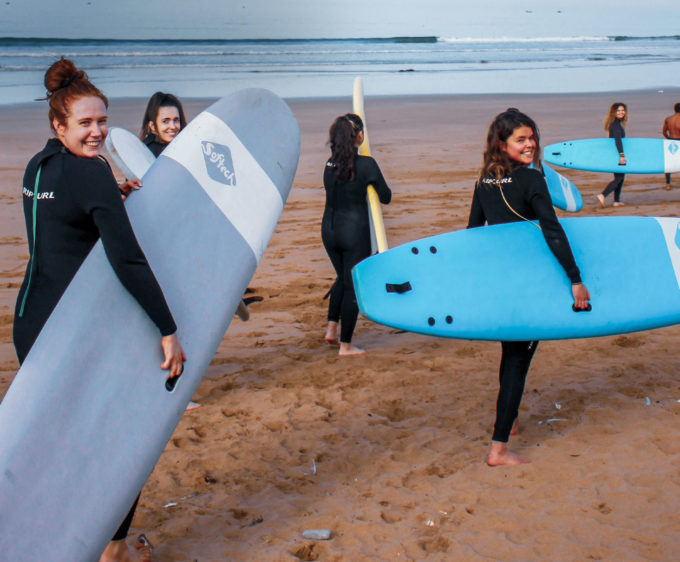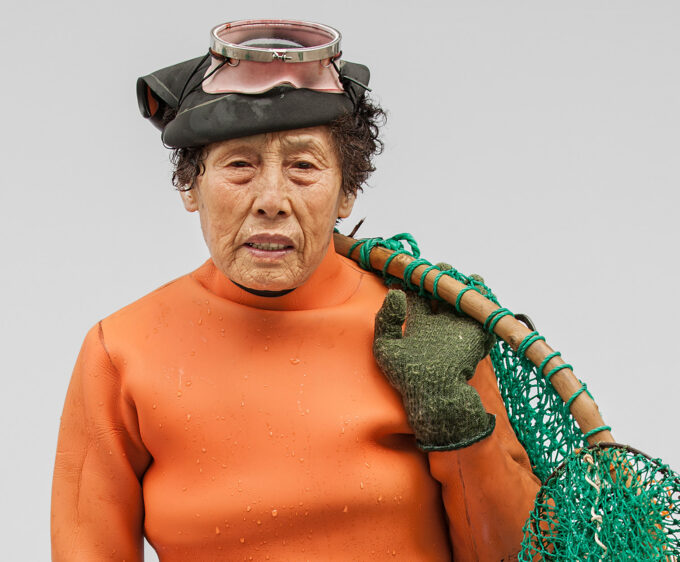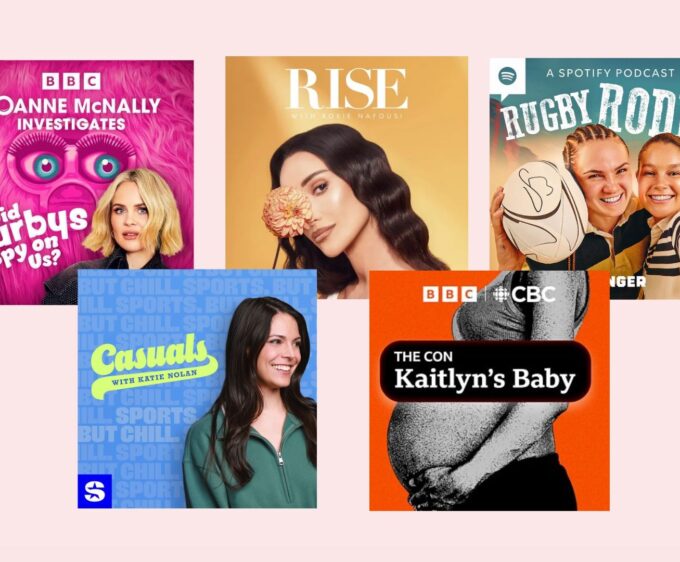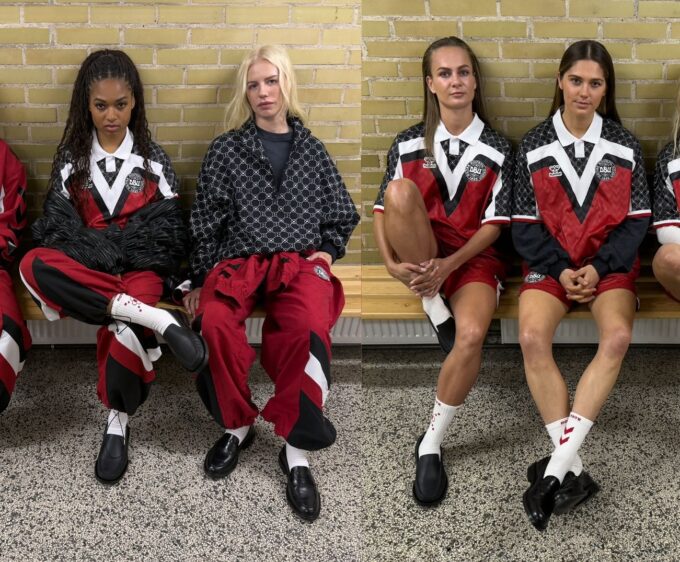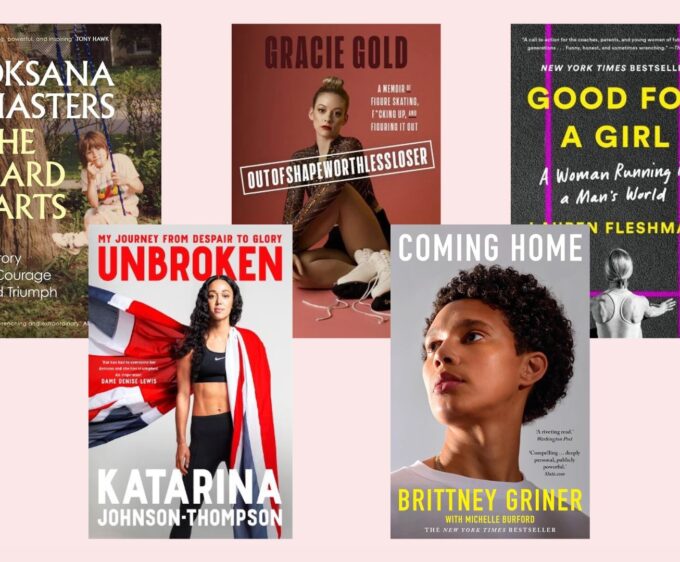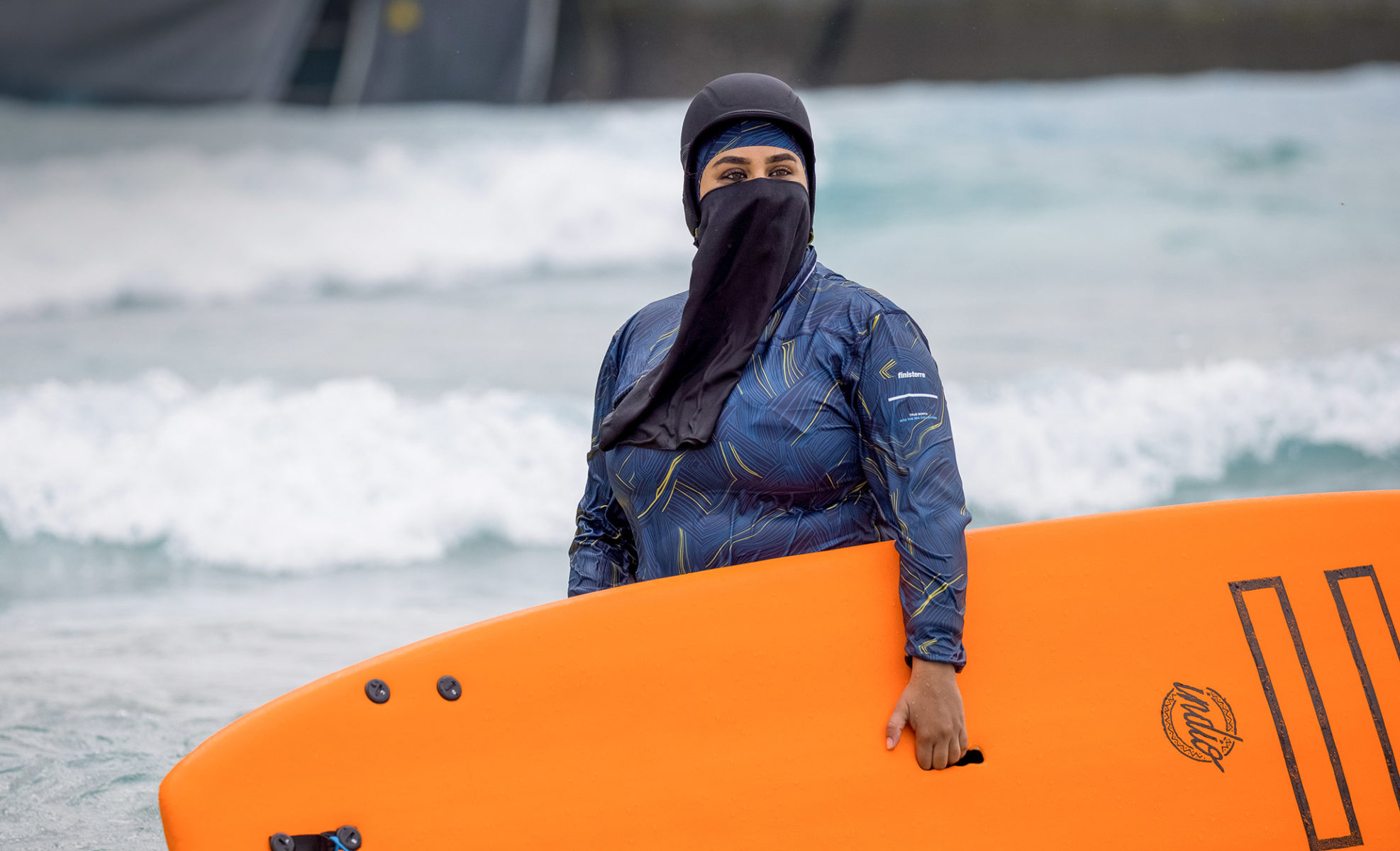
Waves for All
“The clothing was stopping (women) from enjoying the activity they wanted to do.” Irish surfer Easkey Britton talks about the new Seasuit she helped create with Finisterre; a culturally appropriate outfit which offers freedom to women who wish to surf and swim
By Sam Haddad
While teaching surfing in Iran, the Irish surfer Easkey Britton was struck by the lack of culturally appropriate swimwear available for young women. When she came home, she asked the Cornish surf and outdoor brand Finisterre to help her work on a solution. Almost a decade on, as the Seasuit launches, we look at its design journey and how its appeal is extending to a range of water users, not just those who cover for religious reasons.
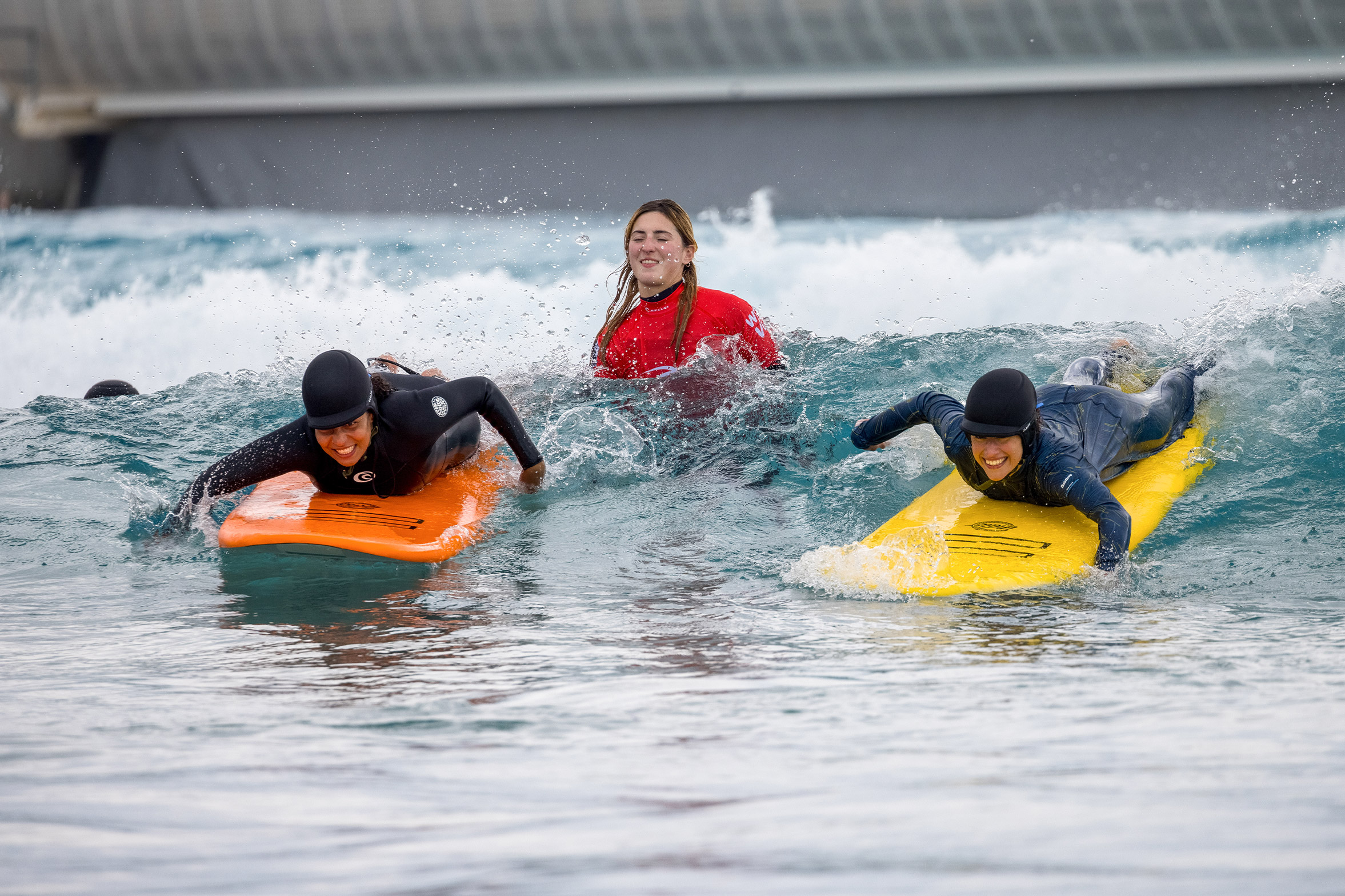
At The Wave, an artificial surf spot just outside of Bristol, a group of women walk into the water, brightly coloured foam boards tucked under their arms. Here for a beginner lesson, they chat nervously, full of the usual worries we all have when we try something new. How is this going to go? Will it be scary? Will I be any good? But one thing they don’t have to be concerned about is feeling body conscious, and whether others will see their shape in a close-fitting wetsuit, because they are all covered in a loose fabric designed to disguise the contours of their body, without getting in their way of their surfing. Some of the group are also wearing hijabs; one of them will later tell me she’s never felt so free. Surfing doesn’t normally look like this. Wherever you go, the line-up is still disproportionately male and white, while the overriding surfer girl aesthetic is a petite, blonde woman in a bikini. But much effort is going into changing the status quo, and today I’m here for the launch of one such initiative: the Seasuit, full coverage swimwear, designed to help break down some of the barriers that put some women off surfing.

The germ of the idea for the Seasuit came back in 2011, when Irish surfer Easkey Britton took a break from studying for a PhD in Environment and Society, to go wave hunting in southeast Iran. There was no trace of a surf scene there at the time but looking at maps and swell charts gave her a hunch she might find waves. She was right. A proud advocate of the many mind and body benefits that surfing can bring, Easkey vowed to return to teach local young women to surf their country’s breaks. Three years later, with filmmaker Marion Poizeau in tow, she did just that, their journey charted in the award-winning documentary Into the Sea. Given the prevailing stereotypes of Iran in the western world, Easkey had expected some pushback from local religious leaders regarding the surf lessons. But, instead, her efforts were welcomed on the condition that all the teachers were women and that the students were covered and wore hijab during their lessons.
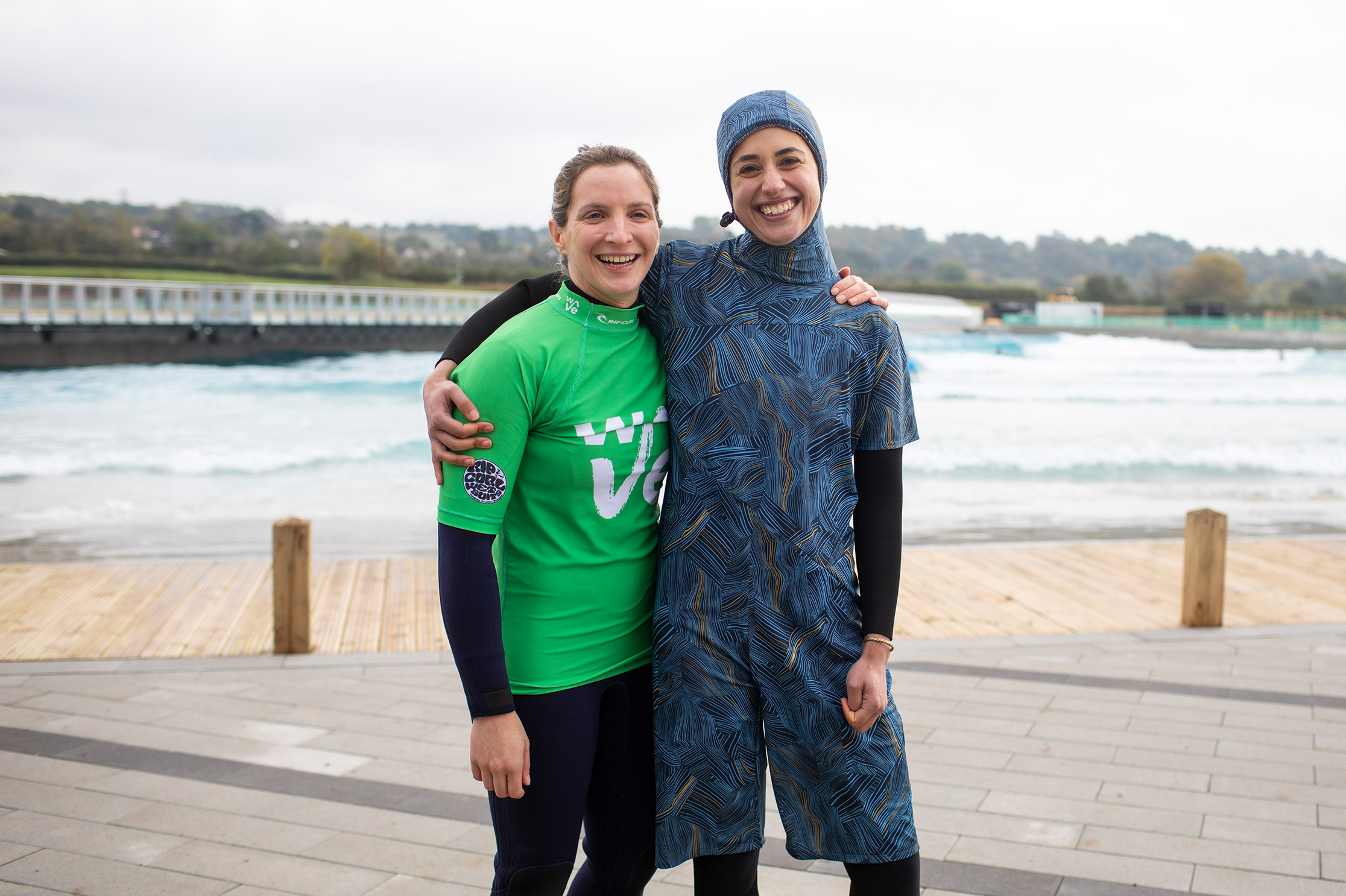
Wearing a hijab was one thing. Easkey wore one throughout her time in Iran, including while surfing, and credits it as one of the reasons locals responded favourably to her. “A big reason surfing was so accepted over there, especially by the powers that be, was that I respected the hijab,” she says. “It was about recognising the need to respect another culture, even if it seems so far removed from my own.”
But being covered while in the water, especially when wetsuits are designed to be figure-hugging to keep you warm, was an extra challenge. They needed culturally appropriate surf wear that was comfy, practical and safe to wear in the breaking waves. Suits which didn’t just cover women’s flesh but also didn’t get caught around their necks and try to drown them. “Not only was it a functional problem,” says Easkey, “but the clothing was actually stopping [women] from doing or enjoying the activity they wanted to do.” Religious dress codes were clearly a barrier to enjoying the waves for many women in the world.
When she came back to the UK, Easkey got in touch with the Cornish surf and outdoor company, Finisterre, who she worked as an ambassador for, and explained the problem. The brand’s product design team were keen to help, and over the past eight years have collaborated with a diverse group of women on the Seasuit, drawing on local expertise along the way.
The original pattern was designed by Synne Knutson, a student at Falmouth University, not far from Finisterre’s workshop base in St Agnes, which was then turned into a working prototype by a team of women designers at the brand, including Rachel Preston and Jess Monk. I ask Jess, a senior product developer at Finisterre, what the main design challenges were? She says the hardest task was minimising the drag of the suit when you’re in the water, which will make sense to anyone who has ever tried to swim in their pyjamas during a school swimming lesson. “It couldn’t be close to the body like a wetsuit, so there was always going to be an element of drag, especially under the arms,” she says. “But you can definitely swim in it. We’ve tested it a lot ourselves at our local beach in Perranporth. Other colleagues have surfed in it too, it’s tight enough that you can duck dive with no problems.”
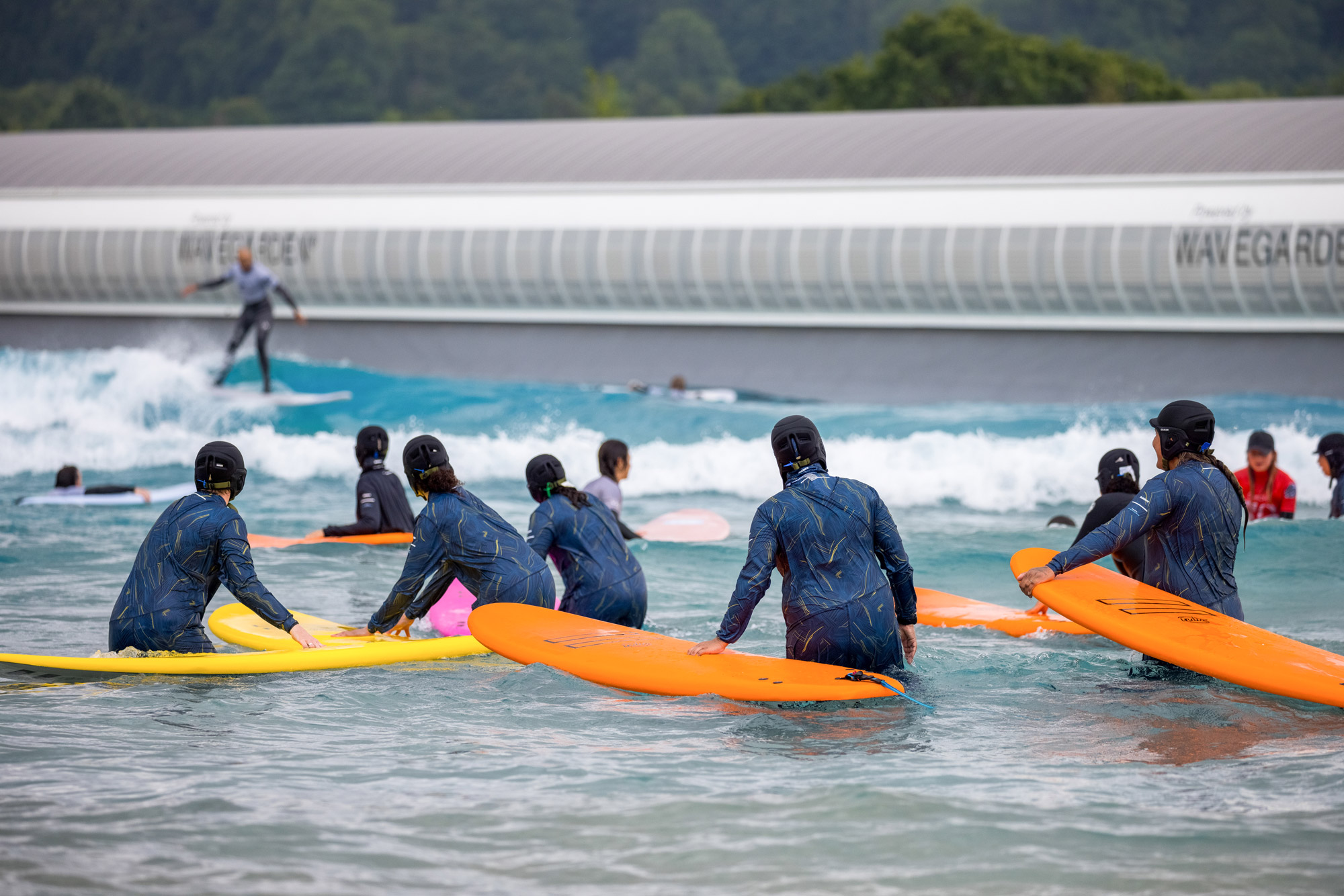
revolution
It helps that the fabric has some stretch in it. Like much of Finisterre’s swim range, it’s made from Seaqual, derived from recycled ocean waste plastics and elastane; it dries quickly and has UV protection in it. The final design is elasticated at the ankles, wrists and collars to hold it in place, and it features an innovative cross-back strap system so wearers can step into the garment and pull it on over a wetsuit or leggings. The geometric print pattern was developed by Ayesha King, a student at Plymouth College of Art. Inspired by the movement of water, Jess says it’s also cleverly designed to disguise the wearer’s shape. “It distracts the eye, so you don’t see the contours of the body,” says Jess. One of the women involved in the Seasuit’s creation was Shirin Gerami, who in 2013 became Iran’s first ever female triathlete. Shirin doesn’t choose to cover herself personally but when she was selected to represent Iran needed to find a culturally appropriate triathlon outfit.
“I naively thought I would just walk into a sports shop and be spoiled for choice,” she says. “The unavailability (of body covering sportswear) was a total surprise to me. I was trying to find options, wearing men’s clothes, mixing and matching things then sending photos to get approved and getting the response, ‘This is too long, this is too tight, and so on.’” Eventually she found an “angelic guy” in a Tehran workshop who went above and beyond to help her create an outfit she could compete in. After her race, people from over the world reached out to connect with her and ask how they too could source full coverage sportswear. She asked several sports brands to get involved and fill the gap in the market but to no avail. Then, she came across Easkey, who’d already made that first visit to Iran but was planning to go back. Shirin joined her on several subsequent trips and has been involved in the Seasuit project ever since.

Shirin, who was born in Iran and lived there from the ages of 10-15, says there isn’t a big culture of girls swimming at the beach let alone surfing in the country. Partly because much of Iran is landlocked, also due to the cost of accessing the coastline, and because of beach babe stereotypes. “A woman by a beach is usually associated with that Californian beach babe image that is propagated everywhere,” she says. “And if you come from a conservative mindset that’s a red flag, but it isn’t necessarily the image it needs to be. Some people might be happy in a bikini, others might think it’s culturally inappropriate, while some might just not feel confident wearing one.” Sabinah Janally from Bristol, one of the women who I meet at The Wave, agrees. Finisterre offered an open invitation for women to come and test the Seasuit at the launch and Sabinah decided to come along. She tells me she’s often felt quite isolated when doing outdoor sports such as hiking, climbing and surfing.
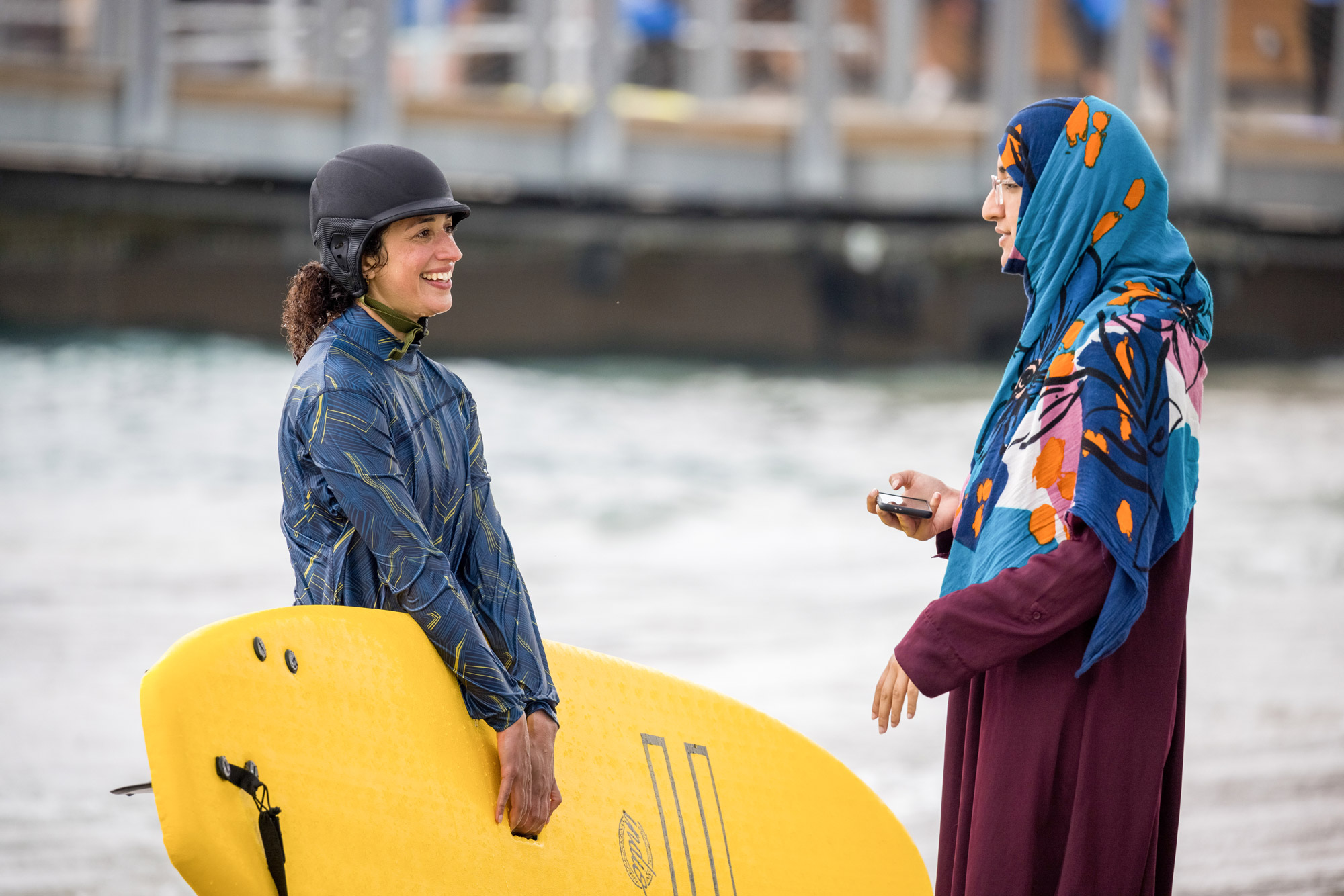
“I’d search but not see myself represented in the community,” she says. At university she wanted to join the surf club but was intimidated by the “surf look”. “I didn’t look like that,” she says. The idea of the Seasuit is “magical” to her, and she feels it has huge potential to make people feel more comfortable and confident in the water. “You often stand out as a minority, but this enables you to feel like you fit in, that you’re welcome and encouraged,” she says. Arooj Shah, from Bradford, also tells me she didn’t see people like her, a young Muslim person of colour, represented in the sports she wanted to do, from horse riding to kayaking. She’d joined the scuba diving club at university and wore a cobbled together “Frankenstein”-style outfit of leggings and a tank top, overlaid with a basketball top and baggy shorts, in order to stay covered and respectful to her Muslim identity.
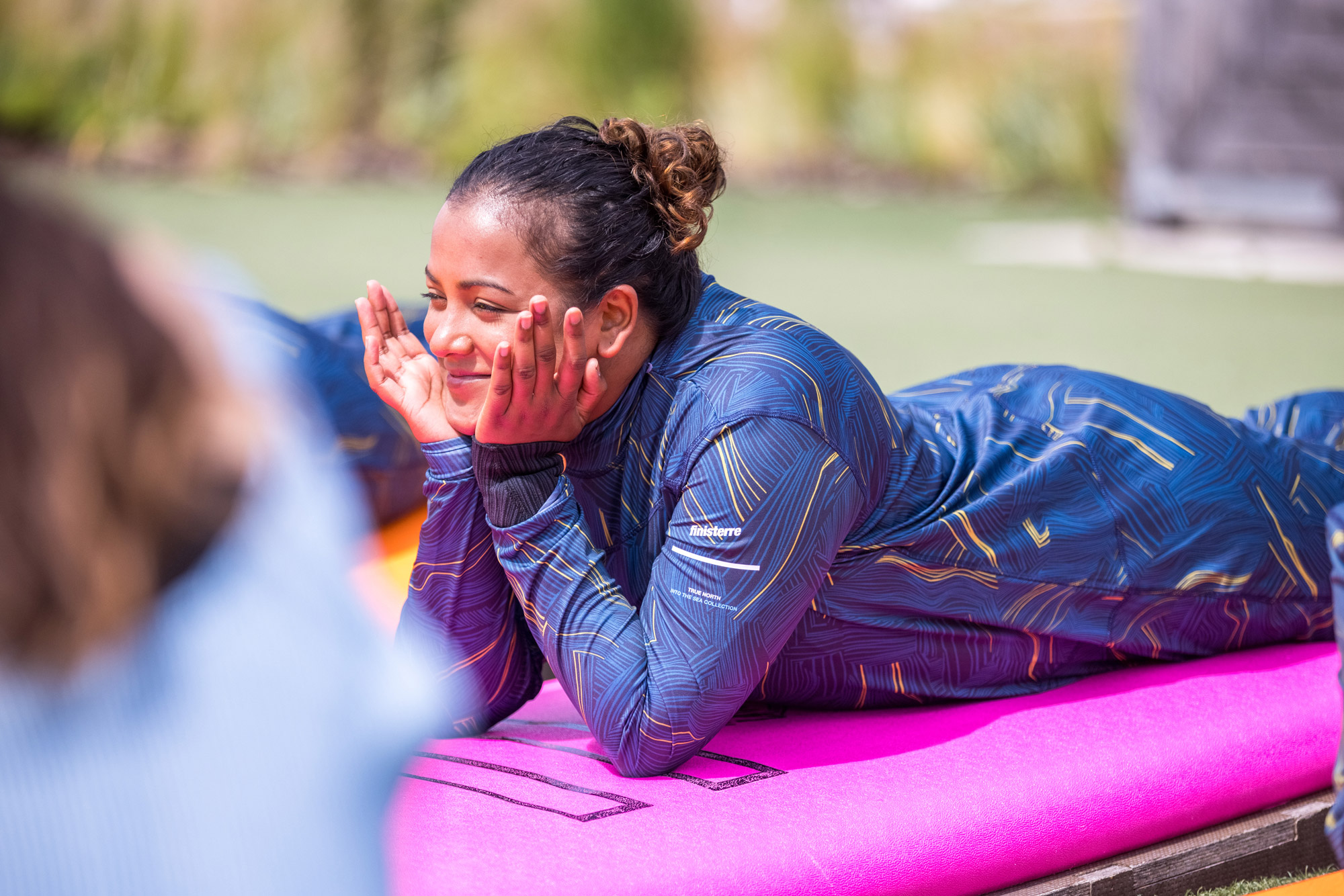
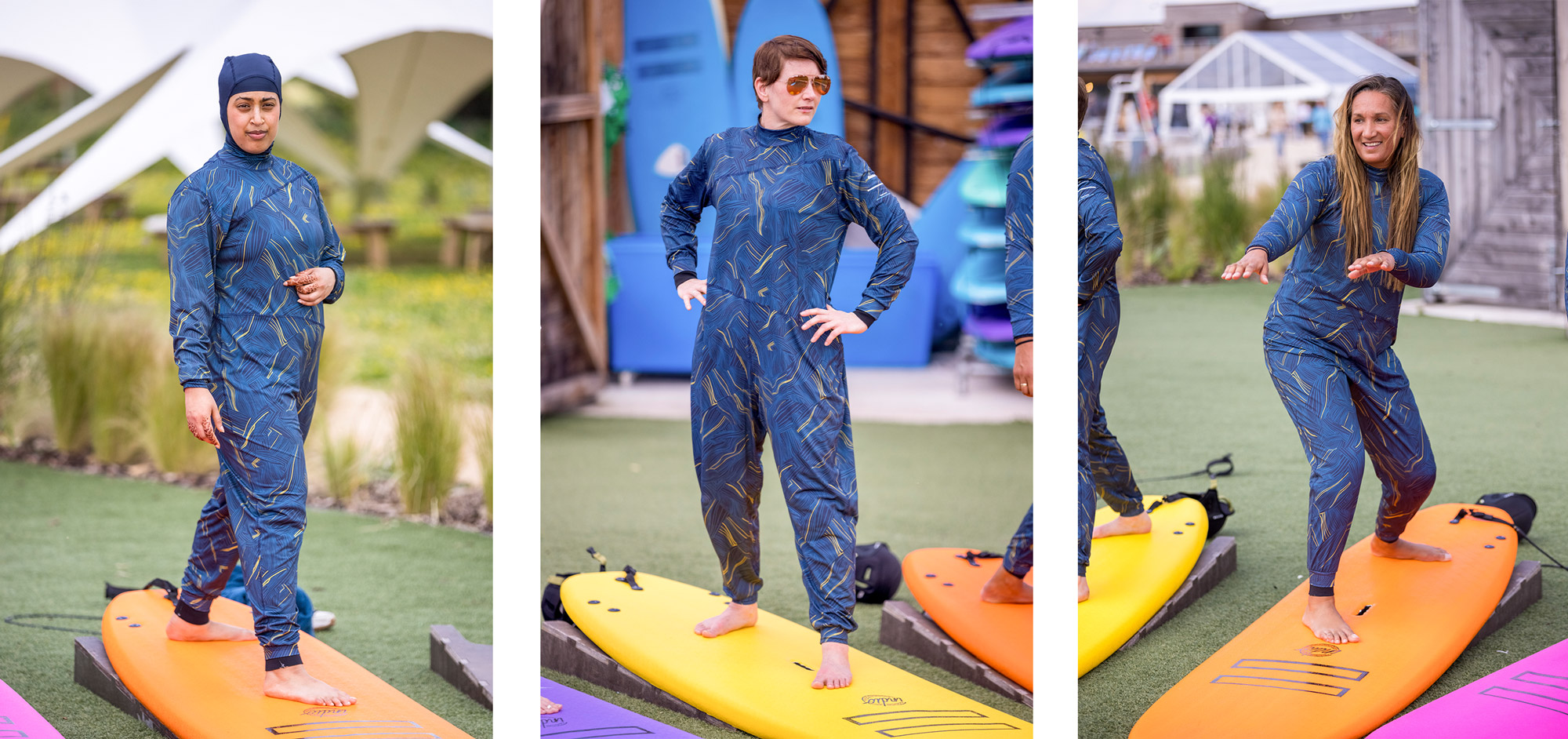
“The group was lovely, but I had to be willing to look ridiculous,” she says, conceding that not everyone would have the confidence to put themselves out there like that. She says she would have loved to have worn something like the Seasuit back then instead. “Kit not being available is a huge barrier in terms of accessibility to sports for Muslim women. It needs to be fit for purpose and to exist, so I know people who look like me are welcome in the sport,” she says, noting how game-changing it could be for Muslim women to see a poster of someone surfing in a Seasuit and hijab at fresher’s week. The hijab is removable so it can be used for other sports, and to broaden the appeal of the Seasuit. During testing the Finisterre team realised the Seasuit wasn’t just appealing to women who wanted to cover up for religious reasons, it was drawing in women who wanted to surf while covered because they were body conscious. And it wasn’t just surfers; swimmers and those who did other water sports such as kayaking were getting in touch, too.

As a plus size woman, Zara Wolf says she’s excited about the Seasuit’s potential to make surfing and even simply swimming at the beach easier to navigate. “People make negative comments all the time,” she says. “I’ve been called “disgusting” on the beach. And these are real barriers to accessing sport and the self-esteem benefits it can provide for plus-size women.” “I don’t like to be looked at and the Seasuit takes that away, giving you freedom from the male gaze. It’s an equaliser,” she says.
The Seasuit is available at Finisterre. For every Seasuit purchased, the Finisterre Foundation will donate one to help someone access the water.
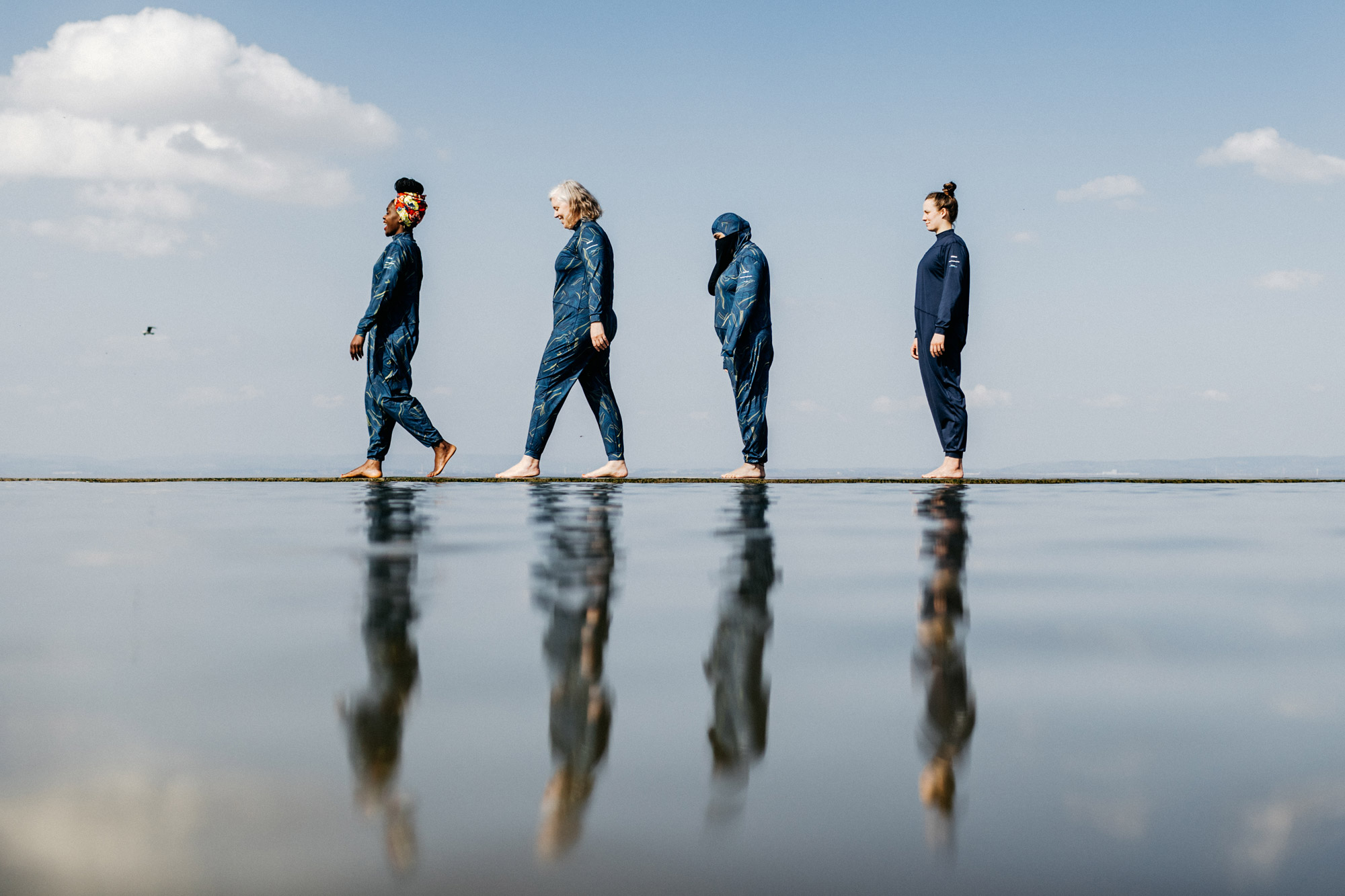
Editorial Design by Root
